2016 HONDA CIVIC QUICK TAKES
TestDriveNow QUICK TAKES: 2016 HONDA CIVIC 1.5T 4D TOURING OVERVIEW
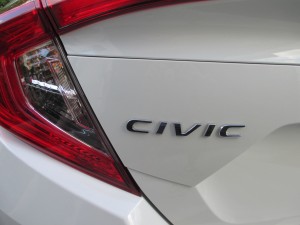 The creation of this new 10th-generation Civic represents one of the most comprehensive and ambitious new-model developments ever undertaken by Honda, requiring an unprecedented commitment of R&D resources and Honda engineering prowess. While the development of the Civic Sedan was led by a North American team – a first for Honda and Civic – the overall Civic series involves design and engineering teams from Honda R&D, sales and manufacturing operations around the world, especially in North America and Japan, but also in Europe, South America and Asia.
The creation of this new 10th-generation Civic represents one of the most comprehensive and ambitious new-model developments ever undertaken by Honda, requiring an unprecedented commitment of R&D resources and Honda engineering prowess. While the development of the Civic Sedan was led by a North American team – a first for Honda and Civic – the overall Civic series involves design and engineering teams from Honda R&D, sales and manufacturing operations around the world, especially in North America and Japan, but also in Europe, South America and Asia.
 In seeking to realize a “dynamic rejuvenation” of Civic and create a new interpretation “in a league of its own,” as the development team defined its mission, Honda engineers set out early during platform development to benchmark the world’s best C-segment vehicles—not only products in Civic’s traditional competitive set, but luxury compact class vehicles such as well.
In seeking to realize a “dynamic rejuvenation” of Civic and create a new interpretation “in a league of its own,” as the development team defined its mission, Honda engineers set out early during platform development to benchmark the world’s best C-segment vehicles—not only products in Civic’s traditional competitive set, but luxury compact class vehicles such as well.
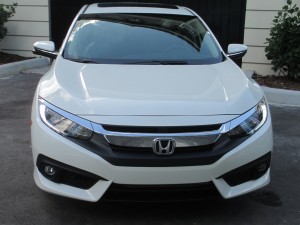 Their evaluation of the world’s best products involved extensive real-world testing, ultimately targeting European luxury vehicles for the new Civic’s ride, handling, steering and NVH (noise, vibration and harshness), and also its interior quality and refinement.
Their evaluation of the world’s best products involved extensive real-world testing, ultimately targeting European luxury vehicles for the new Civic’s ride, handling, steering and NVH (noise, vibration and harshness), and also its interior quality and refinement.
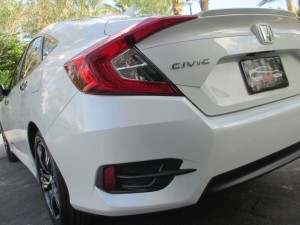 Achieving these lofty aims while meeting requirements for an affordable compact car, in terms of cost, fuel efficiency and manufacturability, stretched the limits of the global Civic team’s engineering capability and demanded new thinking and new approaches to body construction, vehicle aerodynamics, powertrain and chassis design. The result of these efforts is a completely reimagined and reinvented new Civic, the sportiest Civic ever, and a new benchmark in the compact class in terms of spaciousness, fuel efficiency, safety features, interior quality and dynamic performance.
Achieving these lofty aims while meeting requirements for an affordable compact car, in terms of cost, fuel efficiency and manufacturability, stretched the limits of the global Civic team’s engineering capability and demanded new thinking and new approaches to body construction, vehicle aerodynamics, powertrain and chassis design. The result of these efforts is a completely reimagined and reinvented new Civic, the sportiest Civic ever, and a new benchmark in the compact class in terms of spaciousness, fuel efficiency, safety features, interior quality and dynamic performance.
What’s New?
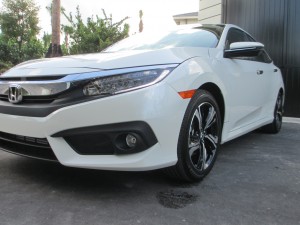 Virtually everything about the 2016 Civic Sedan is new – an all-new vehicle architecture, sporty and sophisticated new interior and exterior styling, a more spacious and high-quality cabin, two advanced new engines, and a host of new premium features and technologies.
Virtually everything about the 2016 Civic Sedan is new – an all-new vehicle architecture, sporty and sophisticated new interior and exterior styling, a more spacious and high-quality cabin, two advanced new engines, and a host of new premium features and technologies.
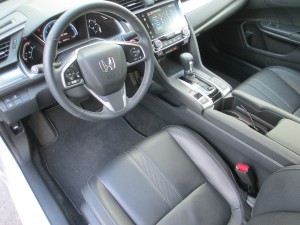 Further, with the addition of Honda Sensing™ safety and driver-assistive technologies and the first application of Honda turbo engine technology to Civic, the 2016 Civic Sedan offers buyers a wider range of options than ever before. Civic models powered by the new 2.0-liter i-VTEC™ engine are designated as the Civic LX and EX trims.
Further, with the addition of Honda Sensing™ safety and driver-assistive technologies and the first application of Honda turbo engine technology to Civic, the 2016 Civic Sedan offers buyers a wider range of options than ever before. Civic models powered by the new 2.0-liter i-VTEC™ engine are designated as the Civic LX and EX trims.
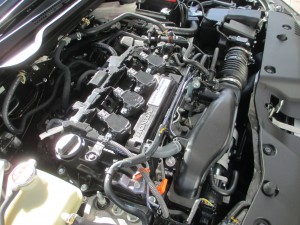 Civic models powered by the new turbocharged 1.5-liter engine are designated as the EX-T, EX-L (with leather-trimmed interior) and new line-topping Civic Touring, which reaches higher into the upper end of the compact car market than ever before.
Civic models powered by the new turbocharged 1.5-liter engine are designated as the EX-T, EX-L (with leather-trimmed interior) and new line-topping Civic Touring, which reaches higher into the upper end of the compact car market than ever before.
Major new technologies, features and capabilities of the 2016 Civic Sedan, depending on trim, are as follows:
Powertrains
- Turbocharged 1.5-liter DOHC direct-injected engine
- 2.0-liter DOHC port-injected i-VTEC engine
- Class-leading anticipated EPA fuel economy ratings of 31/42/35 mpg (city/highway/combined)1 for models with 1.5-liter turbo and CVT and 31/41/35 mpg1 for models with the 2.0-liter engine and CVT
Body
- Ultra-rigid body with 59-percent application of high-strength steel and 14-percent application of ultra-high-strength steel (up from 55 percent and 1 percent, respectively, in the previous model) – the most extensive use of high-tensile steel ever in a Civic
- 68-pound reduction in unibody weight versus the previous Civic Sedan, despite its larger size and greater stiffness
- ACE™ body structure with new crash stroke design (Honda and Civic first) for improved collision performance in a sportier, more compact front frame design
- Ultra-high-strength steel B-pillars and rear frame rails with selectively-tempered “soft zones” for reduced weight and enhanced collision performance (Civic first)
- Ultra-rigid 590-mpa high-strength-steel floor for enhanced collision performance and improved ride quality (Civic first)
- Most tightly sealed Civic body ever, with a 58 percent improvement in air leak performance over the previous model
- Premium noise isolation materials and design features that combine with the tightly sealed body for cabin quietness that challenges luxury-class compact-segment products
Chassis
- New multi-link independent rear suspension
- Hydraulic compliance bushings for premium levels of ride quality and road vibration isolation (Civic first)
- Larger stabilizer bars with bonded bushings for more refined body control (Civic first)
- Rigid aluminum rear damper brackets for improved ride quality (Civic first)
- Agile Handling Assist brake torque vectoring for cornering precision and stability (Civic first)
- Dual-pinion electric power steering with variable gear ratio for improved steering feel and maneuverability (Civic first)
Exterior
- Available LED exterior lighting
- Complete underbody covering for fuel efficiency and cabin quietness
- Flush mounted, acoustic glass windshield
- Capless refueling
Interior
- 97.8 cubic-feet of passenger volume (+3.2 cubic feet vs. previous Civic Sedan) – the most spacious cabin in the compact class
- New ultra-thin A-pillars for enhanced forward visibility
- Premium, soft touch cabin materials exceeding current class standards
- Display Audio touchscreen with Android Auto2 and Apple CarPlay®3 compatibility (Civic first)
- New tilting driver’s seat cushion for improved thigh support
- Premium comfort and convenience features including Remote Engine start, Smart Entry with Push Button Start, electronic parking brake, dual-zone automatic climate control, heated rear seats and rain-sensing wipers
Safety and Driver Assistance
- Honda Sensing™ safety and driver-assistive technologies
- Next-generation ACE™ body structure
- New crash stroke front frame design
- Ultra-rigid 590-mpa high-strength steel floor for enhanced collision performance
- Targeted highest-available collision performance safety ratings – a 5 star Overall Vehicle Score in the NHTSA’s NCAP and a TOP SAFETY PICK+ from the IIHS (Civic first)
Design and Packaging
In designing the new Civic, Honda designers and engineers sought to deliver a sportier and more premium-quality Civic that recaptures the sporty proportions and athletic stance of earlier Civics while thoroughly advancing Civic design into the future.
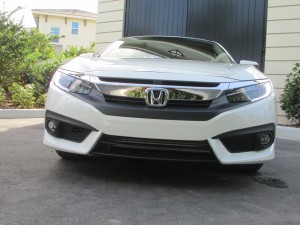 The 2016 Civic Sedan is lower and wider with a short front overhang and long rear deck, and larger wheels and tires that create a more sporting wheel-to-body relationship.
The 2016 Civic Sedan is lower and wider with a short front overhang and long rear deck, and larger wheels and tires that create a more sporting wheel-to-body relationship.
Exterior Design
The taut and tidy overall proportions of the new Civic Sedan are complimented and accentuated by its design details, including its sleek, swept-back bodylines, its sharp and aggressive face, and its bulging wheel arches.
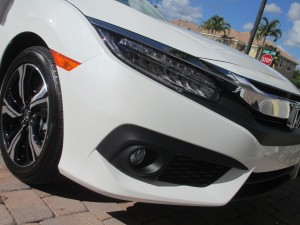 The hood features sharply defined character lines that draw the eye forward and down to the Civic’s aggressive new face, highlighted by a chrome-plated Honda “wing” that runs the full width of the front fascia and is flanked by available new LED headlights in an in-line configuration.
The hood features sharply defined character lines that draw the eye forward and down to the Civic’s aggressive new face, highlighted by a chrome-plated Honda “wing” that runs the full width of the front fascia and is flanked by available new LED headlights in an in-line configuration.
The new Civic’s ultra-thin A-pillars lend the cabin an open, airy feeling with excellent forward visibility, while the aggressively sloped roof line connects seamlessly with gracefully arching C-pillars that carry the curvature of the roof rearward to the outside rear corners of the long deck, where they intersect with distinctive C-shaped “light-pipe” LED taillights.
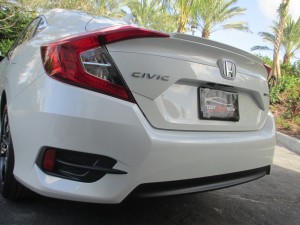 The sharply creased and curving upper-body side line swells over the rear wheel arches and curves aggressively inward to join the upper bend of the distinctive LED taillights, while the upswept lower-body side line is bisected by the bulging rear wheel arches before bending inward to meet up with the rear bumper’s upper surface. The overall effect is one of dynamism and premium quality with an unmistakable and yet thoroughly modern Civic design aesthetic.
The sharply creased and curving upper-body side line swells over the rear wheel arches and curves aggressively inward to join the upper bend of the distinctive LED taillights, while the upswept lower-body side line is bisected by the bulging rear wheel arches before bending inward to meet up with the rear bumper’s upper surface. The overall effect is one of dynamism and premium quality with an unmistakable and yet thoroughly modern Civic design aesthetic.
Interior Package
Honda’s vehicle packaging expertise, along with the Civic’s longer wheelbase and wider body, results in the most spacious interior in the competitive class. With 97.8 cubic feet of interior passenger space, the 2016 Civic Sedan delivers top-of-class comfort by giving its occupants a sense of spaciousness and premium comfort beyond the compact class with ample headroom, legroom, shoulder clearance and side head clearance.
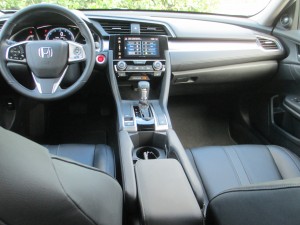 A class leading 84.3 degrees of forward visibility is aided by a new, ultra-thin A-pillar design, 18.2 mm (0.72 inch) narrower than the A-pillar in the outgoing 2015 Civic. Even the forward visibility of rear-seat occupants is taken into account, as the new Civic features newly shaped front seatbacks and a smaller head restraint.
A class leading 84.3 degrees of forward visibility is aided by a new, ultra-thin A-pillar design, 18.2 mm (0.72 inch) narrower than the A-pillar in the outgoing 2015 Civic. Even the forward visibility of rear-seat occupants is taken into account, as the new Civic features newly shaped front seatbacks and a smaller head restraint.
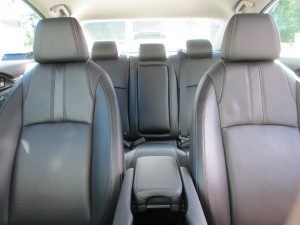 More legroom for the driver is made possible by the reduced intrusion of the instrument panel into the driver’s knee space, while rear-seat foot room is improved by a 27 mm (1.1 inches) wider space between the front seat rails. Trunk room has also been significantly increased, by 2.6 cubic-feet to 15.1 cubic-feet, among the largest in the Civic class, with a lower lift over height, larger rear opening, and wider and taller cargo area than the outgoing model. An all-new reconfigurable center console, with up to 7.2 liters of storage space, can hold multiple full-size iPads or an oversized water bottle, with the console lid closed.
More legroom for the driver is made possible by the reduced intrusion of the instrument panel into the driver’s knee space, while rear-seat foot room is improved by a 27 mm (1.1 inches) wider space between the front seat rails. Trunk room has also been significantly increased, by 2.6 cubic-feet to 15.1 cubic-feet, among the largest in the Civic class, with a lower lift over height, larger rear opening, and wider and taller cargo area than the outgoing model. An all-new reconfigurable center console, with up to 7.2 liters of storage space, can hold multiple full-size iPads or an oversized water bottle, with the console lid closed.
Interior Design
The completely new interior of the 2016 Civic Sedan is designed to match the exciting, modern and sophisticated exterior styling while providing enhanced comfort, leading-edge technology and class-leading quality.
 The 2016 Civic Sedan takes Civic interior quality to a new level. High quality, soft-to-the-touch materials are applied liberally—to the instrument panel, front door sash and door inserts and the larger, more thickly padded center armrest. Fit, finish and materials quality throughout the cabin have been thoroughly modernized and upgraded in keeping with the more premium compact sedan character of this all new Civic.
The 2016 Civic Sedan takes Civic interior quality to a new level. High quality, soft-to-the-touch materials are applied liberally—to the instrument panel, front door sash and door inserts and the larger, more thickly padded center armrest. Fit, finish and materials quality throughout the cabin have been thoroughly modernized and upgraded in keeping with the more premium compact sedan character of this all new Civic.
Interior Comfort, Convenience and Connectivity
The new Civic is designed to be the most comfortable, convenient and connected Civic ever. In addition to its more spacious interior, the 2016 Civic sedan incorporates new, available premium comfort and convenience features – all Civic firsts – as follows:
- Remote Engine start
- Electronic parking brake
- Walk Away Door Locking
- Dual-zone automatic climate control
- Adjustable driver’s-seat thigh support with 14 degrees of tilt
- Heated front seat backs
- Heated rear seat cushions
- Rain-sensing wipers
Display Audio with Apple CarPlay® and Android Auto
 Raising intuitive operation and digital connectivity to the next level, the 2016 Civic Sedan in EX and above trims incorporates a new 7-inch Display Audio touchscreen that serves as the nerve center for control of audio, HVAC and other functions. The new Display Audio is integrated with new Apple CarPlay®3 and Android Auto2 platforms, providing seamless integration of smartphone features and functions, including app-based navigation, streaming audio, voice-controlled search capabilities, and access to a host of Apple- or Google-approved smartphone apps.
Raising intuitive operation and digital connectivity to the next level, the 2016 Civic Sedan in EX and above trims incorporates a new 7-inch Display Audio touchscreen that serves as the nerve center for control of audio, HVAC and other functions. The new Display Audio is integrated with new Apple CarPlay®3 and Android Auto2 platforms, providing seamless integration of smartphone features and functions, including app-based navigation, streaming audio, voice-controlled search capabilities, and access to a host of Apple- or Google-approved smartphone apps.
Dynamic Performance
Civic is designed to set a new bar for dynamic performance in the mainstream compact class, surpassing current offerings and even challenging luxury-class C-segment vehicles in critical areas of dynamic performance such as steering feel, handling precision, ride quality and NVH. With respect to its mainstream, compact-class competitors, Civic is designed to deliver superior dynamic performance in virtually every way, including acceleration and braking performance, refined and linear power delivery, fuel efficiency, steering precision, body control, aerodynamics and NVH. Every element of its design and technology has been optimized to this task.
Powertrain
Powering the 2016 Civic Sedan are two all-new engines, both designed to provide highly refined, responsive and fuel-efficient performance. Civic Sedans in LX and EX trim are powered by a 2.0-liter DOHC, 16-valve, port-injected, inline 4-cylinder engine with i-VTEC™ valvetrain producing a peak 158 hp at 6,500 rpm and 138 lb-ft. of torque at 4,200 rpm, making it the most powerful base engine ever offered in Civic. The new 2.0-liter engine is mated to a sporty continuously variable transmission (CVT) with Honda G-Design shift control, or a quick-shifting 6-speed manual transmission.
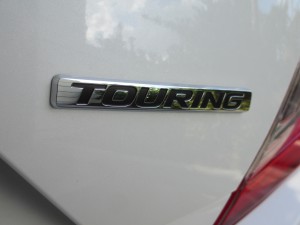 Civic Sedans in EX-T, EX-L and Touring trim are powered by an all-new turbocharged 1.5-liter DOHC, direct-injected and inline 4-cylinder engine with variable cam timing (VTC) and electronic waste gate, turning out 174 hp at 5,500 rpm and peak torque of 162 lb-ft. from 1,800 to 5,500 rpm. The 1.5-liter turbo engine is mated to a new CVT that combines with the low-inertia turbo, VTC and electronic waste gate to optimize power delivery across the engine’s full operating range.
Civic Sedans in EX-T, EX-L and Touring trim are powered by an all-new turbocharged 1.5-liter DOHC, direct-injected and inline 4-cylinder engine with variable cam timing (VTC) and electronic waste gate, turning out 174 hp at 5,500 rpm and peak torque of 162 lb-ft. from 1,800 to 5,500 rpm. The 1.5-liter turbo engine is mated to a new CVT that combines with the low-inertia turbo, VTC and electronic waste gate to optimize power delivery across the engine’s full operating range.
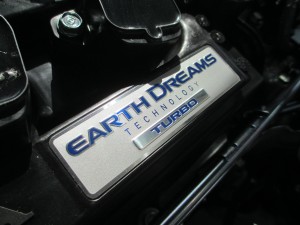 Both engines feature a wide array of friction-reduction design and engineering features that support both high performance and high fuel efficiency. These two ultra-efficient engines, married to the 2016 Civic’s light, rigid and highly aerodynamic body, help the Civic garner anticipated class-leading EPA-estimated fuel economy ratings of 31/41/35 mpg (city/highway/combined)1 for the 2.0-liter engine with CVT and 31/42/35 mpg1 for the 1.5-liter turbo with CVT.
Both engines feature a wide array of friction-reduction design and engineering features that support both high performance and high fuel efficiency. These two ultra-efficient engines, married to the 2016 Civic’s light, rigid and highly aerodynamic body, help the Civic garner anticipated class-leading EPA-estimated fuel economy ratings of 31/41/35 mpg (city/highway/combined)1 for the 2.0-liter engine with CVT and 31/42/35 mpg1 for the 1.5-liter turbo with CVT.
Body
The 2016 Civic Sedan’s new powertrains and sophisticated chassis design are underpinned by its entirely new body construction, where engineers went deeper in the study of dynamic body rigidity to realize an ultra-rigid platform architecture that serves as the foundation for its more sophisticated chassis design, its class-leading collision performance, and its powerful and fuel-efficient powertrains.
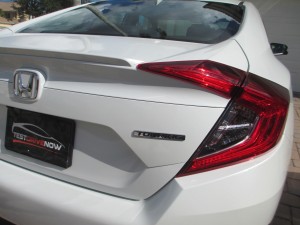 Global bending and torsional rigidity are increased 3.8 percent and 25.8 percent, respectively, and unibody weight is reduced by 68 pounds compared to the previous-generation Civic. Localized body rigidity in key areas, especially at suspension and subframe mounting points is dramatically improved.
Global bending and torsional rigidity are increased 3.8 percent and 25.8 percent, respectively, and unibody weight is reduced by 68 pounds compared to the previous-generation Civic. Localized body rigidity in key areas, especially at suspension and subframe mounting points is dramatically improved.
Key Elements of Civic Body Design:
- 59% application of high-strength steel, the highest in Civic history
- 14% application of ultra-high-strength steel (780 mpa or higher), the highest in Civic history
- New 590-mpa high-strength steel floor for dynamic and collision safety performance (Civic first)
- 20mm “short pitch” door seam welds for enhanced collision performance
- Next-generation ACE body structure with new crash stroke front frame rails (Honda first) for enhanced collision performance in a more compact front frame
- Ultra-high-strength steel B-pillars and rear frame rails with selectively-tempered ‘soft zones’ for reduced weight and enhanced collision performance
Class-Leading Aerodynamics
The new Civic’s sleeker body design combines with aerodynamic features, including nearly full underbody covering, front and rear wheel strakes, optimized rear exhaust silencers and a highly aero-efficient engine compartment, to create the most aerodynamically efficient body in the Civic class. The 2016 Civic Sedan’s Cd*A – the combination of coefficient of drag (Cd) and frontal area (A) – is improved by 12 percent over the outgoing Civic to best-in-class levels, based on Honda internal test data. The Civic aero design was optimized using a combination of advanced CFD (computation fluid dynamics), and wind tunnel testing of highly detailed 25- and 40-percent scale models and a 1:1 full-scale model.
Chassis
Building on the foundation of its ultra-rigid and lightweight body structure, the 2016 Civic Sedan utilizes the most sophisticated chassis design in the history of Civic. Its fully independent suspension includes an all-new multi-link rear design that rigidly mounted to the rear subframe for a high degree of lateral stability.
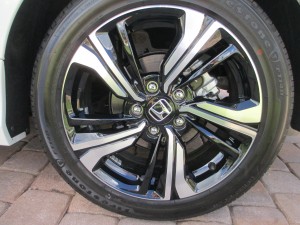 Front and rear hydraulic compliance bushings, a feature typically reserved for larger or more expense vehicles, are also utilized for the first time on Civic, improving ride compliance and reducing road vibrations without compromising sporty handling feel. The new Civic Sedan also applies bonded front and rear stabilizer bushings for smoother and more progressive anti-roll behavior. And Civic’s new dual-pinion electric power steering with variable gear ratio, both Civic firsts, provides for more precise steering control and steering feel—with only 2.2 turns lock-to-lock (vs. 3.1 turns on the previous model) for greatly improved low-speed maneuverability.
Front and rear hydraulic compliance bushings, a feature typically reserved for larger or more expense vehicles, are also utilized for the first time on Civic, improving ride compliance and reducing road vibrations without compromising sporty handling feel. The new Civic Sedan also applies bonded front and rear stabilizer bushings for smoother and more progressive anti-roll behavior. And Civic’s new dual-pinion electric power steering with variable gear ratio, both Civic firsts, provides for more precise steering control and steering feel—with only 2.2 turns lock-to-lock (vs. 3.1 turns on the previous model) for greatly improved low-speed maneuverability.
The new Civic Sedan’s 25mm (0.98 inch) wider track and 20mm (0.78 inch) wider tire tread, compared to previous Civic Sedan, aid flat handling and lateral grip, while its 30mm (1.18 inch) longer wheelbase improved ride quality on undulating or rough road surfaces. The Civic also applies Agile Handling Assist for the first time, using the VSA4 system to apply the brake of the front inside wheel at the entry to a corner, improving cornering attitude, stability and precision.
Key Elements of Civic Chassis Design:
- Dual pinion electric power steering (Civic first)
- Variable gear ratio steering (Civic first)
- Multi-link independent rear suspension (Civic first)
- Electronic parking brake (Civic and segment first)
- Agile Handling Assist (Civic First)
- Wider track (+1.9 inch front, +1.6 inch rear)
- Wider tire tread (+0.78 inch – LX)
Noise, Vibration and Harshness (NVH)
Engineers for the new Civic adopted premium noise-isolating materials and design features to achieve a new level of cabin quietness in the Civic class. This includes the adoption of new methods to measure and reduce air leaks in the Civic body that, based on Honda’s internal test data, is the most tightly sealed body in the competitive class. Full body air leaks have been reduced 58 percent compared to the previous Civic.
Premium noise reduction features include:
- Acoustic glass front windshield
- Triple door sealing (Civic first)
- New hood seals
- Sound-absorbing heat baffles and body undercovers
- A, B and C pillar separators (Civic first)
- New rear wheel house liners
- Formed fiber carpeting (Civic first)
Safety and Driver Assistance
The 2016 Civic Sedan is designed to provide a high level of collision performance in a wide variety of collision scenarios, including offset and oblique-angle frontal collisions, side and rear impacts. The Civic’s safety performance starts with its class-leading forward visibility and precise, stable and predictable steering, handling and braking performance. Standard four-channel anti-lock brakes (ABS) with Electronic Brake Distribution (EBD), Vehicle Stability Assist (VSA) 4 with traction control and Agile Handling Assist further enhance dynamic stability and emergency maneuvering and braking performance.
Honda Sensing™
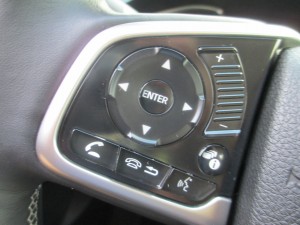
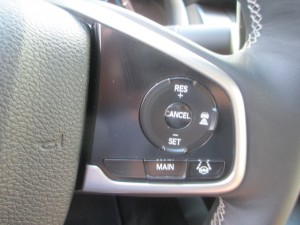 Available Honda Sensing safety and driver-assistive technology can further reduce the potential for a collision and mitigate the consequences, alerting the driver and taking emergency action when a collision is determined to be imminent. Honda Sensing™ uses both millimeter wave radar and a monocular camera to sense and respond to detected road hazards and is available on all models and trims. The Civic Honda Sensing technology suite includes Adaptive Cruise Control with Low Speed Follow for the first time in a Honda vehicle. Honda Sensing features are as follows:
Available Honda Sensing safety and driver-assistive technology can further reduce the potential for a collision and mitigate the consequences, alerting the driver and taking emergency action when a collision is determined to be imminent. Honda Sensing™ uses both millimeter wave radar and a monocular camera to sense and respond to detected road hazards and is available on all models and trims. The Civic Honda Sensing technology suite includes Adaptive Cruise Control with Low Speed Follow for the first time in a Honda vehicle. Honda Sensing features are as follows:
- Collision Mitigation Braking System (CMBS)5
- Lane Departure Warning (LDW)6 integrated with RDM
- Forward Collision Warning (FCW)7 integrated with CMBS
- Adaptive Cruise Control (ACC) with Low Speed Follow8
- Lane Keeping Assist (LKAS)9
- Road Departure Mitigation (RDM)10
All Civics also come equipped with a Multi-Angle Rearview Camera11 and Expanded View Driver’s Mirror.
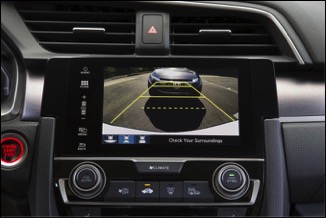
Advanced Safety Body
The 2016 Civic utilizes its advanced body structure – including its s next-generation Advanced Compatibility Body Structure (ACE), new crash stroke technology, 590mpa high-strength steel floor, and tailor-tempered ultra-high strengths B-pillar and rear frame rails (see the Body section) – to provide a high degree of occupant protection while minimizing weight and aiding fuel efficiency.
Engineers were challenged not only to create a body that supported their goals for dynamic performance, but also for top-in-class collision performance. The adoption of a more compact front end and shorter front overhang proved to be an exceptional challenge to achieving their goals, effectively shortening the front frame’s crash stroke (the area available to absorb and redirect frontal collision energy). To overcome this challenge and maintain the sporty proportions of the new Civic, engineers developed a new crash stroke design for the lower front frame rails. The strategic shaping of the frame rail creates a mechanical hinge effect that directs the engine downward in a frontal impact, effectively increasing the front “crash stroke” by 80 mm (3.0 inches).
Advanced Airbag Technology
The Civic utilizes advanced front, side and side curtain airbag technology, including a driver’s front airbag with new spiral stitching for an improved deployment profile; SmartVent® technology for the driver and front passenger side airbags; and a new front passenger airbag with safety vent technology that can mitigate the possibility of injury from airbag deployment when the passenger is “out of position.” These systems work in conjunction with the advanced body structure and optimally tuned interior components to help mitigate injuries in a collision.
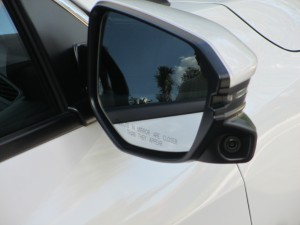 Utilizing these design features and safety technologies, the 2016 Civic Sedan targets the highest available crash protection ratings – a 5-Star Overall Vehicle Score in the NHTSA’s New Car Assessment Program (NCAP), with top ratings in all test modes; and a TOP SAFETY PICK+ rating from the Insurance Institute for Highway Safety, with a score of GOOD in all test modes.
Utilizing these design features and safety technologies, the 2016 Civic Sedan targets the highest available crash protection ratings – a 5-Star Overall Vehicle Score in the NHTSA’s New Car Assessment Program (NCAP), with top ratings in all test modes; and a TOP SAFETY PICK+ rating from the Insurance Institute for Highway Safety, with a score of GOOD in all test modes.
Manufacturing
The 2016 Civic Sedan for the U.S. market will be produced at Honda’s plants in Greensburg, Indiana and Allison, Ontario, Canada, using domestic and globally sourced parts. Its two new engines are produced in Anna, Ohio, at the largest automobile engine plant in Honda’s global production network, and its highly precise CVT transmissions are assembled in Russells Point, Ohio, where two on-site wind turbines provide for upwards of 10 percent of the plant’s power needs.
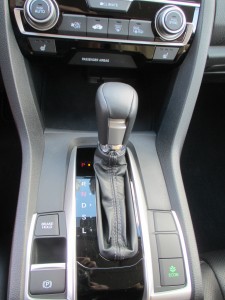 The new Civic also benefits from numerous advancements in manufacturing technology and process that enhance efficiency, quality and performance, as well as associate ergonomics.
The new Civic also benefits from numerous advancements in manufacturing technology and process that enhance efficiency, quality and performance, as well as associate ergonomics.
Inner Frame Weld System
The 2016 Civic body is welded using Honda’s new inner-frame weld process, first utilized in construction of the 2015 Fit. This new process produced a more rigid, lightweight and higher quality body.
Modular Front Sub-Assembly
A new modular front sub-assembly, a first for Honda, improves ergonomics for assembly-line associates, giving them unfettered access to critical interior and front end components before the front sub-assembly is joined to the body.
 This process also helps to ensure a higher level of quality in the assembly process.
This process also helps to ensure a higher level of quality in the assembly process.
 2016 Honda CIVIC 1.5T 4D TOURING MSRP $26,500.00
2016 Honda CIVIC 1.5T 4D TOURING MSRP $26,500.00
 AS SHOWN $27,335.00
AS SHOWN $27,335.00
1 Based on 2016 EPA mileage ratings. Use for comparison purposes only. Your mileage will vary depending on how you drive and maintain your vehicle, driving conditions and other factors.
2 Android and Android Auto are trademarks of Google Inc.
3 Apple CarPlay is a registered trademark of Apple Inc.
Depending on use, Android Auto or Apple CarPlay® can share certain user and vehicle information (e.g., vehicle location, speed and other operating conditions) with Google and its service providers or the connected iPhone, respectively. See Google’s and Apple’s privacy policies for details regarding the use and handling of data uploaded by Android Auto or Apple CarPlay®. Use of Android Auto or Apple CarPlay® is at user’s own risk, and is subject to agreement to the Android Auto or Apple CarPlay® terms of use, which are, respectively, presented to the user when the Android Auto application is downloaded to the user’s Android phone or included as part of the Apple iOS terms of use. Android Auto and Apple CarPlay® vehicle integration is provided “as is,” and Honda cannot guarantee operability or functionality now or in the future due to, among other conditions, changes in the applicable software or operating system, service interruptions, or incompatibility or obsolesce of vehicle-integrated hardware or software. See dealer for details. Only use Android Auto or Apple CarPlay® when conditions allow you to do so safely.
4 VSA is not a substitute for safe driving. It cannot correct the vehicle’s course in every situation or compensate for reckless driving. Control of the vehicle always remains with the driver.
5 CMBS cannot detect all objects ahead and may not detect a given object; accuracy will vary based on weather, speed and other factors. System operation affected by extreme interior heat. System designed to mitigate crash forces. Driver remains responsible for safely operating vehicle and avoiding collisions.
6 LDW only alerts drivers when lane drift is detected without a turn signal in use. LDW may not detect all lane markings or lane departures; accuracy will vary based on weather, speed and road condition. System operation affected by extreme interior heat. Driver remains responsible for safely operating vehicle and avoiding collisions.
7 FCW cannot detect all objects ahead and may not detect a given object; accuracy will vary based on weather, speed and other factors. System operation affected by extreme interior heat. FCW does not include a braking function. Driver remains responsible for safely operating vehicle and avoiding collisions.
8 ACC cannot detect all objects ahead and may not detect a given object; accuracy will vary based on weather, speed and other factors. ACC should not be used in heavy traffic, poor weather or on winding roads. The driver remains responsible to slow or stop the vehicle to avoid a collision.
9 LKAS only alerts drivers when lane drift is detected without a turn signal in use and can apply mild steering torque to assist driver in maintaining proper lane position. LKAS may not detect all lane markings or lane departures; accuracy will vary based on weather, speed and road condition. System operation affected by extreme interior heat. Driver remains responsible for safely operating vehicle and avoiding collisions.
10 Road Departure Mitigation only alerts drivers when lane drift is detected without a turn signal in use and can apply mild steering torque to assist driver in maintaining proper lane position and/or brake pressure to slow the vehicle’s departure from a detected lane. Road Departure Mitigation may not detect all lane markings or lane departures; accuracy will vary based on weather, speed and road condition. System operation affected by extreme interior heat. Driver remains responsible for safely operating vehicle and avoiding collisions.
11 Always visually confirm that it is safe to drive before backing up; the rearview camera display does not provide complete information about all conditions and objects at the rear of your vehicle.

 2017 FORD FOCUS RS VIDEO REVIEW
2017 FORD FOCUS RS VIDEO REVIEW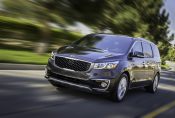 2016 KIA SEDONA SXL QUICK TAKES
2016 KIA SEDONA SXL QUICK TAKES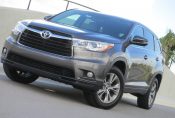 2016 TOYOTA HIGHLANDER QUICK TAKES
2016 TOYOTA HIGHLANDER QUICK TAKES